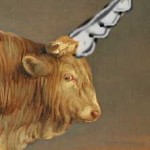With all this current interest in unicorns lately, I decided to shed some light into my own research into the subject. I read an article on Wikipedia that talks about the possible origins of unicorns. They discuss that in the Indus valley there are cylinder seals that have images of an ancient creature that resembles a unicorn. Although this is interesting, the actual books that I’ve read on ancient Sumer and the few chapters I’ve read on Indo-Sumerian seals suggest a much more plausible origin for the mythological beasts. In very ancient times, many depictions of animals were done in 2D. The artists for the Sumerian civilization didn’t use isometric drawing for animals. So even though they made sculptures of animals in three dimensions, the engravings, carvings, and etchings, were primarily done in two dimensional profiles.
One such animal that was of primary importance for the Ancient Sumerians was the bull. The bulls back then were the primary form of useful currency. In many ways, bulls were valued more than gold.
The reason why bulls were depicted so often in tablets and cylinder seals, was because the keeping of financial records was extremely important. These transactions were the basis of tracking wealth and organizing one’s inventory of their most important resources.
As we all know, bulls have two horns. So at first glance, they couldn’t possibly be the origin of unicorns. But in fact if you look at how bulls were portrayed in 2D profile, they look like they only have one horn. This is because the artists most likely felt that since the bulls’ horns were symmetrical, and everyone knew bulls had two horns. So people could determine that the cylinder seal was depicting a bull even if they only drew one horn.
There are many instances of Sumerian artists actually doing the opposite and carving both horns into the pictures. But these pictures look kind of funny. I can see why some artists chose to omit the second horn.
Well, if you take a look at these bull images, it definitely is easy to see how some people who may have never seen a bull before may have gotten the idea that some animals only had one horn that protruded from their foreheads.
So what may have happened is that someone or a group of people with active imaginations took the image of a single horned bull, and applied the concept of the horn from the forehead to a horse. This concept may have been already reinforced by perhaps a sighting of a Narwhal in the ocean. But I think Wikipedia overstates this possibility in the origins of the Unicorn. The reason for my speculation on this is because Narwhals usually live in the arctic regions, and so ancient peoples didn’t live near them. So the Sumerians were too far away from Narwhals to let them enter their collective unconscious.
But what may have happened is that when European peoples encountered Narwhals literally thousands of years after Sumerian civilization ended, the sight of the single horned sea creatures could have reinforced their conceptions and mythologies of the Unicorn.
The transition of a Unicorn from a bull to a horse may not be as big a stretch of the imagination as one may think. Bulls and horses are both large and powerful animals that have tremendous value even to this day. Both mammals have hooves. And they both have strong and muscled necks. So it makes sense that the Unicorn transitioned to the body of a horse in more modern culture.
A possible origin of the magical power attributed to the unicorn horn has a quite simple hypothesis. The horns of bulls had tremendous value. They could be for both financial and/or agricultural purposes. This doesn’t even mention the possible military application or decorative functions the bull horns could have had. So to think that the horn of a Unicorn was magical, could have been an evolved embellishment of the horn’s actual value in more ancient times. Remember a horn, or a head, or how many “heads” of bar (bulls) a landowner had, was a shorthand description of his wealth. And wealth and magic go hand in hand.
-Tyler
Sources:
Indo-Sumerians Seal Deciphered, PG: 15, L. Austine Waddell (Author), Kessinger Publishing, LLC
Wikipedia: Unicorn
http://en.wikipedia.org/wiki/Unicorn#Unicorn_seals_of_the_Indus_Valley_Civilization
The Sumerians, C. Leonard Woolley (Author), W. W. Norton & Company (September 17, 1965),
